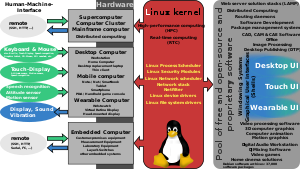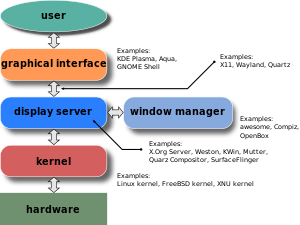| Revision as of 14:14, 25 May 2014 editCzarkoff (talk | contribs)Extended confirmed users, Pending changes reviewers, Rollbackers18,494 editsm →History: fixed archivedate in citation template← Previous edit | Revision as of 19:20, 8 June 2014 edit undoScotXW (talk | contribs)Extended confirmed users14,417 edits they target EXACTLY the GNOME ShellNext edit → | ||
| Line 15: | Line 15: | ||
| | website = {{URL|https://wiki.gnome.org/Projects/GnomeShell}} | | website = {{URL|https://wiki.gnome.org/Projects/GnomeShell}} | ||
| }} | }} | ||
| ] '''GNOME Shell''' is designed to be operated via ] and ] as well as via ]. ]-based, GNOME Shell supports ].]] | |||
| ], an ] and ]]] | |||
| '''GNOME Shell''' is the default graphical front-end of the ] ] starting with version 3,<ref name="gnome-3-planning" /> which was released on April 6, 2011. It provides basic functionality like launching applications, switching between ] and is also a ]. GNOME Shell replaced ]<ref name="shell-replaces-panel" /> and other software components from GNOME 2 to offer a user experience that breaks from the previous model of ], used in earlier versions of GNOME. | '''GNOME Shell''' is the default graphical front-end of the ] ] starting with version 3,<ref name="gnome-3-planning" /> which was released on April 6, 2011. It provides basic functionality like launching applications, switching between ] and is also a ]. GNOME Shell replaced ]<ref name="shell-replaces-panel" /> and other software components from GNOME 2 to offer a user experience that breaks from the previous model of ], used in earlier versions of GNOME. | ||
Revision as of 19:20, 8 June 2014
 GNOME Shell 3.10 in overview mode GNOME Shell 3.10 in overview mode | |
| Developer(s) | The GNOME Project |
|---|---|
| Initial release | April 6, 2011; 13 years ago (2011-04-06) |
| Repository | |
| Written in | JavaScript and C |
| Operating system | Unix-like |
| Available in | Multilingual |
| Type | |
| License | GPL |
| Website | wiki |


GNOME Shell is the default graphical front-end of the GNOME desktop environment starting with version 3, which was released on April 6, 2011. It provides basic functionality like launching applications, switching between windows and is also a widget engine. GNOME Shell replaced GNOME Panel and other software components from GNOME 2 to offer a user experience that breaks from the previous model of desktop metaphor, used in earlier versions of GNOME.
GNOME Shell is written in C and also in JavaScript as a plugin to Mutter.
Design
As default graphical front-end/graphical shell/UX/UI of the GNOME desktop environment, its design is guided by the GNOME Human Interface Guidelines (HIG). The primary hardware target is a touchscreen the size of a Netbook/Tablet computer, though it is also employable on bigger displays with keyboard and mouse.
Components
The GNOME Shell comprises of following graphical and functional elements:
- Top bar
- System status area
- Activities Overview
- Dash
- Window picker
- Application picker
- Search
- Notifications and messaging tray
- Application switcher
Software architecture
GNOME Shell is tightly integrated with Mutter, a compositing window manager and Wayland compositor. It is based upon Clutter to provide visual effects and hardware acceleration According to GNOME Shell maintainer Owen Taylor, it is set up as a Mutter plugin largely written in JavaScript. and uses GUI widgets provided by GTK+ version 3.
Features
Changes to the user interface (UI) include, but are not limited to:
- Clutter supports multi-touch gestures.
- A new Activities overview, which houses:
- A dock (called "Dash") for quickly switching between and launching applications
- A window picker, similar to Mac OS X's Mission Control, also incorporating a workspace switcher/manager
- An application picker
- Search
- A messaging tray, an area at the bottom of the screen used for housing both interactive and static notifications separately from system status icons
- "Snapping" windows to screen borders to make them fill up a half of the screen or the whole screen
- A single window button by default, Close, instead of three (configurable). Minimization has been removed due to the lack of a panel to minimize to, in favor of workspace window management. Maximization can be accomplished using the afore-mentioned window snapping, or by double-clicking the window title bar.
- A fallback mode is offered in versions 3.0–3.6 for those without hardware acceleration which offers the GNOME Panel desktop. This mode can also be toggled through the System Settings menu. GNOME 3.8 removed the fallback mode and replaced it with GNOME Shell extensions that offer a more traditional look and feel.
Extensibility
The functionality of GNOME Shell can be changed with extensions, which can be written in JavaScript. Users can find and install extensions using the GNOME extensions website. Some of these extensions are hosted in GNOME's git repository, though they are not official.
Gallery
Adoption
- The Linux distribution Fedora uses GNOME Shell by default since release 15.
- Ubuntu doesn't use GNOME Shell by default, but users are able to install it from the Ubuntu repositories since version 11.10. In addition, an Ubuntu Gnome Remix is released alongside Ubuntu 12.10. An official GNOME edition of Ubuntu released by Canonical Ltd. with Ubuntu 13.04 and it was named Ubuntu GNOME.
- The GNOME version of openSUSE 12.1 uses GNOME Shell by default.
- Arch Linux dropped support of GNOME 2 in favor of GNOME 3 in its repositories.
- Mageia will have the current version of GNOME in its version 2.
- Debian Wheezy (stable) and Sid (unstable) make GNOME 3.4 available.
- Sabayon Linux uses latest version of GNOME Shell.
Reception
See also: Controversy over GNOME 3GNOME Shell has received mixed reviews: It has been criticized for a variety of reasons, mostly related to design decisions and reduced user control over the environment. For example, users in the free software community have raised concerns that the planned tight integration with Mutter will mean that users of GNOME Shell will not be able to switch to an alternative window manager without breaking their desktop. In particular, users might not be able to use Compiz with GNOME Shell while retaining access to the same types of features that older versions of GNOME allowed.
Reviews have generally become more positive over time, with upcoming releases addressing many of the annoyances reported by users.
History
The first concepts for GNOME Shell were created during GNOME’s User Experience Hackfest 2008 in Boston.
After criticism of the traditional GNOME desktop and accusations of stagnation and lacking vision, the resulting discussion lead to the announcement of GNOME 3.0 in April 2009. Since then Red Hat is the main driver of GNOME Shell’s development.
Pre-release versions of GNOME Shell were first made available in August 2009 and became regular, non-default part of GNOME in version 2.28 in September 2009. It was finally shipped as GNOME’s default user interface on 6 April 2011.
See also
- GNOME
- Controversy over GNOME 3
- Unity, a shell interface for GNOME created by Ubuntu
- Cinnamon, a shell interface for GNOME used by Linux Mint
References
- "GNOME 3 Myths", GNOME Live!, retrieved December 19, 2010
{{citation}}:|chapter=ignored (help) - Module Statistics: gnome-shell, retrieved February 14, 2011
- "Planning for GNOME 3.0", GNOME Live!, retrieved March 23, 2011
- Sharma, Apoorva (March 23, 2010), "Why does Gnome-shell replace the current gnome-panel", gnome-shell-list mailing list, retrieved August 18, 2012
- "GNOME Shell Design". Retrieved May 21, 2014.
- Kissling, Kristian (July 8, 2009), "Mutter: Window Manager in GNOME's Future", Linux Pro Magazine, retrieved March 23, 2011
- Cutler, Paul (July 1, 2009), Behind the Scenes with Owen Taylor, retrieved November 25, 2011
- Taylor, Owen (March 23, 2009), "Metacity, Mutter, GNOME Shell, GNOME-2.28", desktop-devel-list mailing list, retrieved August 18, 2012,
gnome-shell is set up as a Mutter plugin that is largely written in JavaScript
- Ljubunčić, Igor (April 6, 2011), Gnome 3 Fallback mode - Get your productivity back, Dedoimedo, retrieved November 25, 2011
- "GNOME 3.7: what is happening now | Goings on". Blogs.gnome.org. December 5, 2012. Retrieved March 12, 2013.
- "Extensions", GNOME Live!, retrieved November 25, 2011
- Releases/15/FeatureList, Fedora Project, retrieved November 25, 2011
- "OneiricOcelot/ReleaseNotes - Ubuntu Wiki", ] Wiki, retrieved April 18, 2012
- Andrew (October 19, 2012). "Prefer GNOME Shell? Download Ubuntu GNOME Remix 12.10 ~ Web Upd8: Ubuntu / Linux blog". Webupd8.org. Retrieved March 12, 2013.
- "Introduction to Ubuntu GNOME".
- Portal:12.1, OpenSuSE Project, retrieved November 25, 2011
- Bîru, Ionuț Mircea (April 30, 2011), "GNOME3 in extra", Arch Linux, retrieved December 4, 2011
- "Release Notes", Mageia Wiki, March 7, 2012, retrieved March 24, 2012
- "/ packages / sid (unstable) / gnome / gnome-shell", Debian, retrieved July 10, 2012
- "/ packages / wheezy (testing) / gnome / gnome-shell", Debian, retrieved July 10, 2012
- Taylor, Owen (March 24, 2009), "Re: Metacity, Mutter, GNOME Shell, GNOME-2.28", desktop-devel-list mailing list, retrieved August 18, 2012
- Wallen, Jack (March 28, 2014). "GNOME 3.10 has resurrected what was once the darling of the Linux desktop". TechRepublic. Archived from the original on March 28, 2014.
{{cite web}}: Unknown parameter|deadurl=ignored (|url-status=suggested) (help) - Matt Hartley, Chris Fisher (January 5, 2014). "In Defense of Gnome 3". Linux Action Show. Jupiter Broadcasting. Retrieved April 2, 2014.
{{cite web}}: CS1 maint: date and year (link) - "My glimpse at Gnome-Shell". Mad for Ubuntu. Archived from the original on May 23, 2010.
- "Boston2008/GUIHackfest - GNOME Live!". Live.gnome.org. October 14, 2008. Retrieved March 12, 2013.
- "Timeline: The Greatest Show on Earth". Be the signal. March 15, 2011. Retrieved March 12, 2013.
- "gnome in the age of decadence". wingolog. June 7, 2008. Retrieved March 12, 2013.
- "Planning for GNOME 3.0". Mail.gnome.org. April 2, 2009. Retrieved March 12, 2013.
- Matthew Garrett (mjg59) wrote, 2010-10-26 18:39:00 (October 26, 2010). "mjg59: Fun facts". Mjg59.livejournal.com. Retrieved March 12, 2013.
{{cite web}}: CS1 maint: numeric names: authors list (link) - "ftp.gnome.org". Ftp.acc.umu.se. Retrieved March 12, 2013.
- "GNOME 2.28 Release Notes". Library.gnome.org. Retrieved March 12, 2013.
- "TwoPointNinetyone - GNOME Live!". Live.gnome.org. March 24, 2011. Retrieved March 12, 2013.
- "GNOME 3.0 with GNOME Shell officially launched | ITProPortal.com". Thinq.co.uk. Retrieved March 12, 2013.
External links
| GNOME | |||||||||||||||||
|---|---|---|---|---|---|---|---|---|---|---|---|---|---|---|---|---|---|
| Core Applications | |||||||||||||||||
| Extras |
| ||||||||||||||||
| Components |
| ||||||||||||||||
| Community | |||||||||||||||||
| People | |||||||||||||||||
| Desktop environments and window managers based on X11 or Wayland | |||||||||
|---|---|---|---|---|---|---|---|---|---|
| Desktop environments (comparison) |
| ||||||||
| Graphical shells | |||||||||
| X window managers (comparison) |
| ||||||||
| Wayland compositors | |||||||||
| Related | |||||||||
Categories:

